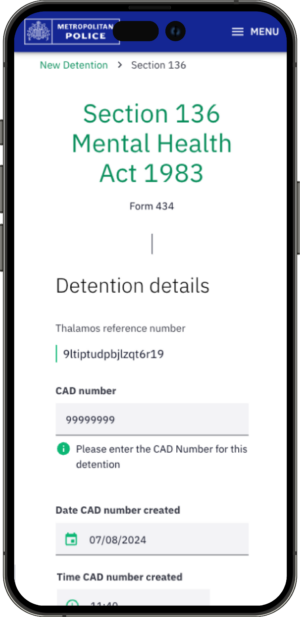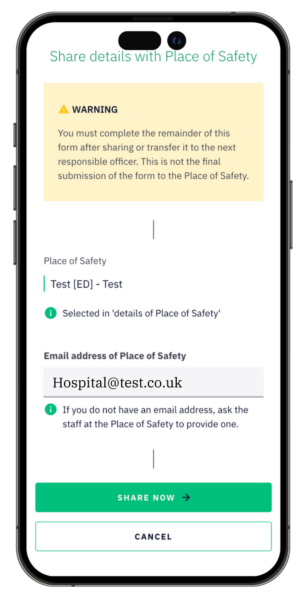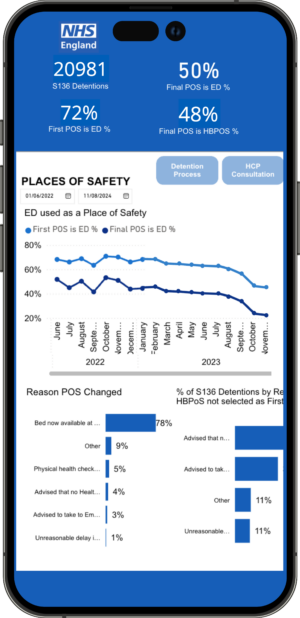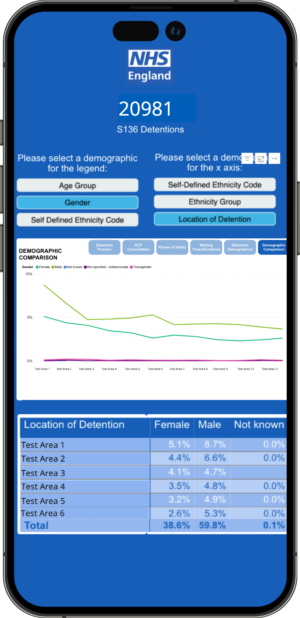Thalamos 136
Some 35,000 Metropolitan police officers, covering the whole of London, have Thalamos 136 deployed on their devices.
The 24-hour evolving nature of 136 incidents requires a highly specialist feature set able to capture inputs from multiple officers and NHS users, which includes single sign-on and live forms.

Headline benefits
The data generated by Thalamos Section 136 is hugely rich. Unlike paper or traditional electronic record systems, the patient specific information may be entirely anonymised to provide a wholly IG compliant means by which to report on the use of the Act.
Daily, weekly, monthly and annual visibility on challenges within the “136 pathway”. Delays at specific NHS sites, waiting times for Ambulances, incident durations compared across a sites.
Designed to be used at an operational level to identify potential areas of improvement and to engage with partner organisations. Also at a strategic level to inform strategies for reducing the use of 136 or identifying areas of service that require improvement.
May also be used for national reporting and benchmarking against other Police Services.
Clear overview of in-flight incidents enabling swifter handovers of care to the most appropriate locations for people detained under Section 136.
- Helps mental health and acute hospitals process patient admissions more swiftly, releasing police back to duty
- In context access to 111 mental health triage tools to support officers with decision-making as to whether a Section 136 is necessary or not
- Full data integrations with existing command and control systems removes requirement for officers to double key data into multiple systems
- Reduces duplication of information
- Provides oversight of all in-flight incidents, locations and duration of police attendance
- Tracks section 136 time from entry to place of safety to assessment
Integration

Integration
Integration with SSO enables one click access with no username and password required.
- Access to active directory permits seamless transfer of live forms between different officers
- Transfer of forms between officers allows co-authoring. This is especially important given the potential for 136 incidents to span across multiple officer shifts
- In-progress forms may be shared ahead of time with Ambulance and NHS professionals
- Live forms capture accurate “pathway” data as they record events as they unfold
Digital Handover

Digital Handover
Digital Handover allows Officers to share forms securely.
- Clear record of transfer of legal responsibility for a detained person from police officers to health staff
- Encourages cooperation and communication between police and NHS staff
- Best practice by design
- Tooltips and guidance designed to encourage best practice, improving safety of the detained person
- Reduces opportunities for errors when filling in forms
- Immediate access to 136 policy which can be updated to provide evergreen compliance with legislation
System Benefits

System Benefits
- Data captured provides a new level of insight to 136 pathways that highlights opportunities for process improvement and reducing police involvement
- Less admin time spent by police and health services completing, conveying, and filing physical paperwork
- Higher level of information security provided by Single Sign-On and data sharing agreements between police and health services
- Improved working relationship between police and NHS colleagues that encourages better practice.
- Improved experience for patients detained under the MHA
Data & Dashboards

Data & Dashboards
Thalamos 136 provides real time accurate data including, but not limited to, pathway information, waiting times, methods of transport, use of force and social determinants. Previously, understanding the realities of the Section 136 Pathway was incredibly challenging, time consuming and error prone.
By deploying Thalamos 136, Police Services can realise “In-flight” dashboards
- Live view Section 136 incidents in progress
- An overview of the use of 136 by team, area or whole Police Service. Including patient demographics, use of force and incident outcomes
- Designed to allow specialist teams to intervene day to day where appropriate